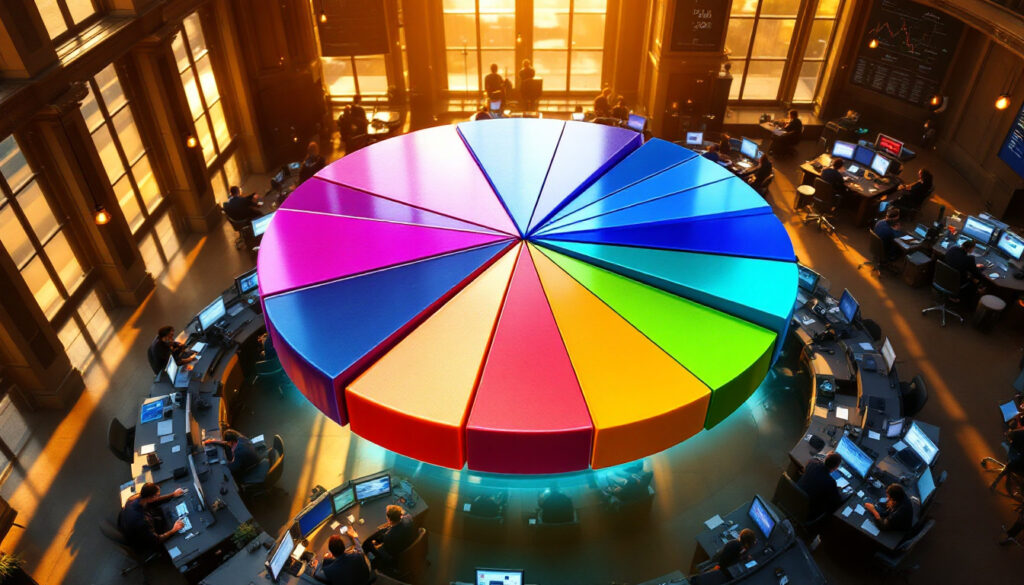Understanding the ASX 200 Index
The S&P/ASX 200 Index (ASX: XJO), commonly known as the ASX 200, is Australia's benchmark stock market index comprising the 200 largest companies by market capitalization listed on the Australian Securities Exchange (ASX). Established as a key performance indicator, the index accounts for approximately 80% of the total value of the Australian share market, making it a reliable proxy for the overall health of the Australian economy.
The ASX 200 serves as more than just a statistical measure—it's a vital barometer of Australia's economic landscape and a critical tool for investors seeking broad market exposure. Since its introduction in April 2000, the index has become the institutional standard for measuring the performance of Australia's equity market and serves as the foundation for numerous investment products.
What Makes the ASX 200 Different from Other Indices?
The ASX 200 differs significantly from other Australian indices such as the All Ordinaries Index (ASX: XAO), which tracks the top 500 companies. While both indices cover Australia's larger companies, the ASX 200's more concentrated focus delivers a distinct investment profile with different risk-return characteristics.
The key difference lies in the ASX 200's stringent liquidity requirements. Companies must demonstrate sufficient trading volume to ensure investors can efficiently enter or exit positions without causing significant price disruptions. This focus on liquidity makes the ASX 200 particularly relevant for institutional investors managing large portfolios.
Unlike indices in technology-dominant markets like the United States, the ASX 200 maintains substantial exposure to traditional sectors such as banking and resources, reflecting Australia's economic foundations. This sector composition provides investors with exposure to Australia's economic powerhouses with generally lower volatility than smaller companies. For those interested in more specific market segments, a beginner's guide to investing in mining stocks can provide valuable insights into this significant sector within the ASX 200.
How the ASX 200 is Calculated and Maintained
The index employs a free-float market-capitalization weighting methodology, where companies are weighted according to their available market value rather than their total market capitalization. This approach ensures the index reflects the actual investment opportunity available to investors, excluding shares held by insiders, governments, or strategic investors that rarely trade.
Standard & Poor's (S&P) rebalances the ASX 200 quarterly in March, June, September, and December to ensure it accurately reflects the 200 largest ASX-listed companies. During these rebalancing periods, companies may be added or removed based on their market capitalization ranking and liquidity metrics. The average daily turnover requirement is particularly important, ensuring all index constituents maintain sufficient trading activity.
This regular rebalancing maintains the index's relevance as companies grow, shrink, or new listings emerge. Only companies with ordinary or preferred shares that meet specific liquidity requirements qualify for inclusion. Notably, hybrid securities with both equity and fixed-income characteristics are excluded from consideration, preserving the index's focus on pure equity performance.
Why is the ASX 200 Important?
The ASX 200 serves multiple crucial functions in Australia's financial ecosystem, extending beyond simply tracking share prices to providing essential infrastructure for the investment community and broader economy.
Benchmark for Investment Performance
The index provides a standardized yardstick against which investors can compare the performance of individual stocks or entire portfolios. Professional fund managers are often evaluated based on their ability to outperform the ASX 200, with performance metrics frequently expressed in terms of excess returns above the index.
Many investment funds specifically aim to either replicate or outperform the ASX 200's returns. However, historical data shows this is challenging—over the past decade, only about 32% of actively managed Australian equity funds have managed to outperform the index after accounting for fees, highlighting the efficiency of simply tracking the index itself.
Pension funds (superannuation) with collective assets exceeding AUD 3.4 trillion use the ASX 200 as their primary domestic equity benchmark, underscoring its significance in retirement planning for millions of Australians. This widespread adoption has cemented the index's position as the definitive performance standard for the Australian market. Those looking to enhance their investment approach may benefit from mastering stock market strategies for long-term success.
Economic Indicator
As it represents approximately 80% of Australia's listed company value, the ASX 200's performance often reflects broader economic trends and investor sentiment about Australia's economic outlook. The index demonstrates a correlation coefficient of 0.75 with Australia's GDP growth over the past two decades, making it a reliable leading indicator of economic expansion or contraction.
During periods of economic uncertainty, movements in the ASX 200 can signal changing market expectations before these shifts appear in official economic data. For example, the index declined 36% during the early stages of the COVID-19 pandemic, anticipating the subsequent 7% contraction in Australia's GDP before rebounding strongly as economic stimulus measures took effect.
The Reserve Bank of Australia frequently references ASX 200 movements in its monetary policy considerations, particularly when assessing financial conditions and market confidence. This integration into policy frameworks further emphasizes the index's role as a macroeconomic barometer.
Diversification Tool
By tracking 200 companies across multiple sectors, the index offers investors a way to gain diversified exposure to the Australian economy through index-tracking investment products. Modern portfolio theory suggests that holding between 20-30 stocks can achieve approximately 90% of potential diversification benefits, making the ASX 200's breadth particularly valuable for risk management.
Exchange-traded funds (ETFs) that track the ASX 200 have seen substantial growth, with assets under management exceeding AUD 25 billion across various products. These funds provide instant diversification with a single transaction, allowing investors to efficiently allocate to the Australian market without selecting individual securities. For those interested in exploring ETF options, an in-depth guide to ASX ETFs can provide valuable information.
The index's broad market coverage helps mitigate company-specific risks while maintaining exposure to Australia's economic growth trajectory. This combination of diversification and representative coverage makes the ASX 200 particularly valuable for both domestic and international investors seeking Australian market exposure.
Sectors Within the ASX 200
What Are the 11 ASX 200 Sectors?
The ASX 200 classifies its constituent companies into 11 distinct sectors based on the Global Industry Classification Standard (GICS), providing investors with a structured view of Australia's economic landscape. This classification system helps investors understand sectoral trends and construct balanced portfolios across different segments of the economy.
The Financials sector encompasses banks, insurance companies, and financial service providers, making up approximately 35% of the index. Australia's banking system is notably concentrated, with the "Big Four" banks collectively holding about 75% of household deposits and dominating mortgage lending across the country.
The Materials sector includes mining companies, chemical producers, and construction material manufacturers, comprising around 23% of the index. This sector's prominence reflects Australia's resource-rich geography, with the nation ranking as the world's largest exporter of iron ore and a leading producer of coal, gold, and lithium.
Healthcare companies represent about 11% of the index, including pharmaceutical firms, medical equipment manufacturers, and healthcare providers. The sector has grown at a compound annual growth rate of 9% since 2015, outpacing the broader market as Australia's aging population drives increased healthcare spending.
Consumer Discretionary businesses make up roughly 7% of the index, covering retailers, media companies, and other non-essential consumer goods providers. This sector's performance typically aligns with consumer confidence and disposable income trends, making it a useful indicator of household financial health.
Consumer Staples account for approximately 5% of the index, including food producers, supermarkets, and essential household goods manufacturers. These companies typically demonstrate defensive characteristics during economic downturns, as demand for essential products remains relatively stable regardless of economic conditions.
Industrials represent about 6% of the index, encompassing transportation, construction, and engineering companies that form the backbone of Australia's infrastructure and logistics networks. Many of these firms benefit from government infrastructure spending programs, which have expanded significantly in recent years.
The Energy sector makes up roughly 4% of the index, featuring oil and gas producers and explorers. While Australia has traditionally been a net energy importer, the development of liquefied natural gas (LNG) export capacity has transformed the nation into one of the world's largest LNG exporters.
Information Technology companies contribute approximately 4% of the index, including software developers, IT service providers, and hardware manufacturers. Though smaller than in other developed markets, this sector has demonstrated strong growth as digital transformation accelerates across the Australian economy.
Real Estate accounts for about 7% of the index, comprising property developers and Real Estate Investment Trusts (REITs). The sector provides exposure to both commercial and residential property markets, with many REITs offering attractive dividend yields supported by rental income.
Communication Services represent roughly 5% of the index, including telecommunications providers, media, and entertainment companies. Australia's telecommunications landscape is dominated by a few large players, with significant infrastructure investments in fiber and 5G networks driving the sector's development.
Utilities make up about 3% of the index, covering electricity, gas, and water providers, including renewable energy companies. This sector is experiencing significant transformation as Australia transitions toward renewable energy sources, with several major utilities pivoting their generation portfolios toward wind and solar.
Which Sectors Dominate the ASX 200?
The ASX 200 has a distinct sector composition that reflects Australia's economic strengths and natural resource advantages. This sector weighting differs significantly from other global indices, with Australia having greater exposure to financials and materials compared to technology-heavy indices like the US S&P 500.
The Financials sector is the largest, dominated by the "Big Four" banks: Commonwealth Bank, NAB, Westpac, and ANZ. These institutions collectively comprise approximately 25% of the entire index, creating significant concentration risk. Their outsized influence means that regulatory changes or economic factors affecting the banking sector can have substantial impacts on the overall index performance.
The Materials sector ranks second, featuring mining giants like BHP and Rio Tinto that leverage Australia's vast mineral wealth. The sector's prominence reflects Australia's position as a global resource powerhouse, with mining contributing approximately 14% of GDP despite employing only about 2% of the workforce—highlighting the capital-intensive nature of these operations.
The Healthcare sector comes third, led by global biotech company CSL Limited and hearing implant manufacturer Cochlear Limited. CSL alone accounts for over 6% of the index, making it one of the most influential individual stocks. The company's global leadership in plasma therapies and vaccines provides Australian investors with exposure to international healthcare markets.
This sectoral concentration creates distinct risk-return characteristics for the ASX 200. During commodity booms, the materials sector can drive substantial index gains, as witnessed in 2021 when iron ore prices peaked at USD 230 per tonne. Conversely, banking sector challenges, such as those faced during the 2018 Royal Commission into Misconduct in Banking, can disproportionately weigh on index performance.
Top Companies in the ASX 200
The Three Largest ASX 200 Companies
The ASX 200 is headlined by market leaders that represent the pillars of Australia's corporate landscape. These companies not only dominate their respective sectors but also influence broader market trends through their substantial index weighting.
BHP Group Ltd (ASX: BHP)
BHP stands as Australia's largest company by market capitalization, with a valuation exceeding AUD 150 billion. This diversified mining giant operates globally across five continents, employing over 80,000 people in operations spanning more than 90 locations. The company's roots trace back to 1885 when it began as a silver, lead, and zinc mine in Broken Hill, New South Wales.
The company produces a range of commodities including coal, iron ore, copper, and nickel, with iron ore operations in Western Australia's Pilbara region forming the backbone of its business. BHP's iron ore assets benefit from world-class ore grades averaging 61-62% Fe content, compared to global averages of 30-40%, providing significant cost advantages in global markets.
BHP's strategic focus has shifted toward "future-facing" commodities essential for the energy transition, including copper, nickel, and potash. The company's Jansen potash project in Canada represents one of the largest greenfield investments in the sector, positioning BHP to capitalize on growing global fertilizer demand driven by food security concerns.
Considered a blue chip stock with a relatively lower risk profile than smaller mining companies, BHP typically distributes 50-70% of its earnings as dividends, making it a cornerstone holding for income-focused investors. The company's financial strength is reflected in its "A" credit rating and conservative balance sheet management approach.
Commonwealth Bank of Australia (ASX: CBA)
Commonwealth Bank holds the position of Australia's largest bank and financial institution, with a market capitalization of approximately AUD 130 billion. The bank maintains the largest branch and ATM network in Australia, serving over 15 million customers and employing more than 48,000 staff across retail, business, and institutional banking divisions.
The bank provides retail, commercial, and institutional banking services, with particularly strong market positions in home lending and household deposits. CBA holds approximately 25% of Australia's mortgage market, with a loan book exceeding AUD 500 billion, giving it unparalleled scale in the country's banking system.
Founded in 1911 as Australia's national bank and fully privatized in 1996, CBA has transformed from a government institution into a financial services conglomerate. Its subsidiary businesses extend beyond traditional banking to encompass wealth management, insurance, and investment services, though recent regulatory changes have prompted some divestment of non-core operations.
CBA's technological leadership within Australia's banking sector has driven superior customer acquisition and retention metrics, with the bank consistently reporting the highest customer satisfaction scores among the major banks. This focus on digital capabilities has helped maintain CBA's premium valuation relative to banking peers, typically trading at a 20-30% P/E premium to the sector average.
CSL Limited (ASX: CSL)
CSL Limited has emerged as a global biotechnology leader with a market capitalization of approximately AUD 120 billion. The company specializes in rare and serious disease treatments, particularly those derived from human plasma. Its collection network spans more than 300 centers across the United States, Europe, and China, making it the world's largest plasma collection organization.
The company develops treatments for rare and severe diseases, focusing on immunoglobulins, coagulation factors, and specialty products for conditions including primary immune deficiencies, hereditary angioedema, and hemophilia. CSL's flagship product, Hizentra, has become the global market leader in subcutaneous immunoglobulin therapy.
CSL also produces influenza vaccines and other therapies through its Seqirus division, which ranks as the second-largest influenza vaccine provider globally. The company's cell-based manufacturing technology represents a significant advancement over traditional egg-based production, offering potential advantages in pandemic response scenarios.
Founded in 1916 as Commonwealth Serum Laboratories to provide Australians with quality healthcare, CSL began as a government entity before privatization in 1994. Since then, the company has delivered exceptional shareholder returns, with its share price increasing more than 100-fold over the past 25 years through a combination of organic growth and strategic acquisitions.
How to Invest in the ASX 200
Direct Investment in ASX 200 Companies
Investors can purchase shares in individual ASX 200 companies through a broker, allowing for tailored exposure to specific businesses or sectors. This approach enables investors to implement precise investment strategies based on their outlook for particular industries or companies within the index.
Direct investment provides several advantages, including the ability to overweight high-conviction positions while avoiding less attractive companies or sectors. For example, an investor concerned about climate policy impacts might underweight coal producers while increasing exposure to renewable energy providers, despite their respective index weightings.
Dividend-focused investors may prefer direct ownership to maximize franking credit benefits, as Australian companies typically distribute imputation credits with their dividends that can reduce shareholders' tax liabilities. By selecting companies with high franking levels, investors can enhance after-tax returns beyond headline dividend yields.
This approach allows for selective exposure to specific companies or sectors but requires more active management and potentially higher transaction costs. Brokerage fees typically range from $5-30 per trade with Australian brokers, which can significantly impact returns for smaller investment amounts or frequent traders. Additionally, investors need sufficient capital to achieve adequate diversification, as purchasing meaningful positions across multiple companies requires substantial investment.
Investing Through ASX 200 ETFs
Exchange-Traded Funds (ETFs) that track the ASX 200 offer a simpler way to gain exposure to the entire index through a single investment. These funds hold all 200 constituent companies according to their index weights, providing comprehensive market coverage without the complexity of managing multiple positions.
Benefits include instant diversification across all 200 companies, eliminating single-stock risk and providing exposure to the broader market performance. This approach requires minimal investment knowledge or time commitment, making it particularly suitable for newer investors or those preferring passive strategies.
ETFs typically charge lower costs compared to buying individual shares, with management expense ratios averaging 0.10-0.15% annually. The compounding effect of these fee savings is significant—a $10,000 investment growing at 7% annually would incur approximately $2,400 in fees over 20 years with an actively managed fund (1.5% fee) versus just $240 with an ETF (0.1% fee).
Popular ASX 200 ETFs include Vanguard Australian Shares Index ETF (VAS), iShares Core S&P/ASX 200 ETF (IOZ), and SPDR S&P/ASX 200
Want to Identify the Next Major ASX Discovery?
Stay ahead of the market with Discovery Alert's proprietary Discovery IQ model that instantly notifies you about significant mineral discoveries on the ASX before the broader market reacts. Visit Discovery Alert's discoveries page to explore how historic mineral discoveries have generated exceptional returns and begin your 30-day free trial today.




